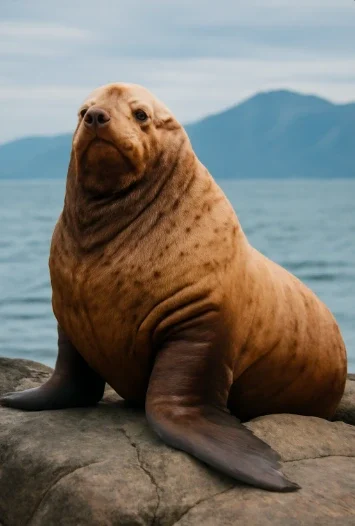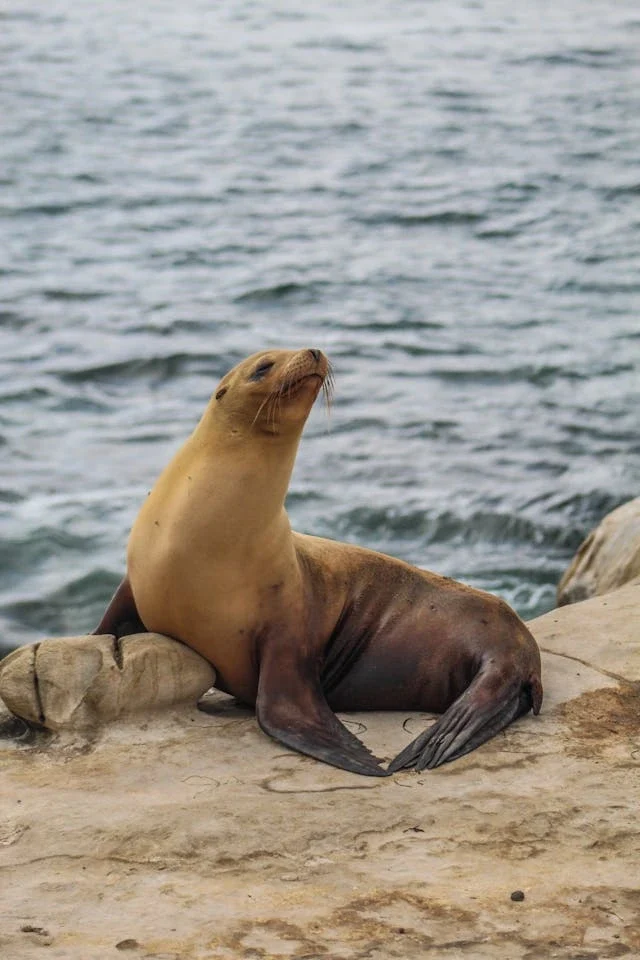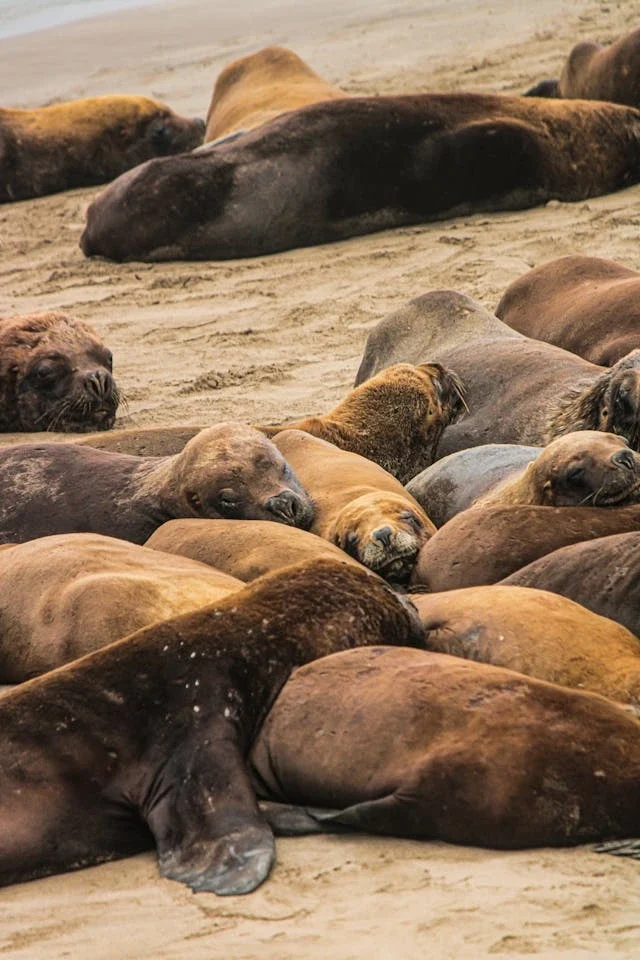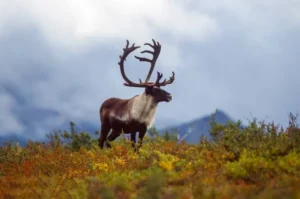| Feature | Details |
| Scientific Name | Eumetopias jubatus |
| Max Size | Males: Up to 11 ft, 2,400 lbs. Females: 9 ft, 800 lbs |
| Diet | Pollock, cod, salmon, squid, and crab |
| Average Lifespan | Up to 30 years in the wild |
| Swimming Speed | Up to 25 mph |
| Diving Depth | Can dive as deep as 600 feet |
| Population | Western DPS: 39,774 non-pups, 12,953 pups (2024) Eastern DPS: 70,000+ |
| Conservation Status | Western DPS: Endangered, Eastern DPS: Delisted in 2013 |
| Vocalization | Loud barks, growls, and roars, especially during breeding season |
| Habitat | Coastal waters of Alaska, Aleutian Islands, Bering Sea |
When you think of wild Alaska, one of the most iconic creatures you’ll encounter is the Steller’s Sea Lion (Eumetopias jubatus). These giant marine mammals have earned a place in the hearts of Alaskans and visitors alike for their size, intelligence, and importance to the coastal ecosystems of the Aleutian Islands and the Bering Sea.
All About Steller’s Sea Lion
Steller’s Sea Lions are the largest species of sea lion in the world, and their massive size and distinctive features set them apart from other marine mammals. They are part of the Otariidae family, which also includes seals and walruses.
Steller Sea Lion Size Compared to Humans
Let’s compare Steller’s Sea Lions to humans to give you a sense of their size:
- Males can reach up to 11 feet (3.4 meters) in length and weigh as much as 2,400 pounds (1,100 kilograms).
- Females are smaller, averaging about 9 feet (2.7 meters) in length and weighing between 800–1,000 pounds (360–450 kilograms).
To put that into perspective, a male Steller’s Sea Lion weighs four times the average human and is twice as long!
Steller Sea Lion Weight and Diet

Steller Sea Lion Weight
- Male Steller Sea Lions can weigh between 990–2,470 lbs (450–1,120 kg), with an average weight of 1,199 lbs (544 kg).
- Females weigh about 530–770 lbs (240–350 kg), with an average of 580 lbs (263 kg).
These giant mammals have robust bodies and massive necks, which help them thrive in the cold waters of Alaska. Males tend to be heavier due to their larger frame and muscular build.
Steller Sea Lion Diet
These pinnipeds are opportunistic feeders, eating a wide variety of prey depending on availability. Their diet mainly consists of:
- Fish: Pollock, Pacific cod, halibut, salmon, and rockfish.
- Cephalopods: Various squid and octopus.
- Crustaceans: Crab, sculpins, and scampi.
They consume about 50 pounds of food each day to support their large bodies. They are skilled hunters, diving to depths of 600 feet to catch their prey, and often hunt in groups to take down large schools of fish.
Steller Sea Lion Population and Conservation Status

The population has been monitored closely, especially since the species’ population decline in the western stock. Here’s the latest data from the 2024 surveys:
Population Data (2024):
- Total Population (2024):
- 22,082 non-pups
- 7,017 pups
- These numbers were counted across 148 haul-out sites in Alaska and Russia.
Western DPS (Endangered):
- Non-pups: 39,774 individuals (95% Confidence Interval: 36,626–43,078).
- Pups: 12,953 pups (95% Confidence Interval: 11,996–13,990).
- Annual Growth Rates:
- Non-pups: +0.96% annually.
- Pups: +0.90% annually.
Regional Changes:
- Western Aleutians: -5.67% decline in non-pups and -4.07% decline in pups per year.
- Central Aleutians: Relatively stable, but with high uncertainty due to low survey coverage.
- Eastern Aleutians: +2.36% increase in non-pups.
Conservation Status:
- Western DPS remains endangered.
- Eastern DPS was delisted in 2013 after recovery, with around 70,000 individuals in the Gulf of Alaska.
Challenges:
- Marine heatwaves (2014–2016) and overfishing of key prey species have negatively impacted their populations.
- Predation by killer whales and sharks is also a threat to juvenile sea lions.
Steller Sea Lion Teeth and Hunting Adaptations

- Sharp Teeth: They have large, sharp canine teeth for gripping and tearing fish, squid, and crabs.
- Powerful Jaws: Their robust jaws allow them to handle large prey like pollock and cod, tearing through the tough skin.
- Adapted for Hunting: The teeth are designed to withstand the pressure of gripping fast-moving fish and to hold slippery prey in cold waters.
- Nocturnal Hunting: They often hunt at night, using their keen sense of smell and sight to track fish.
- Social Hunters: They often hunt in groups, which helps them catch prey that is harder to get on their own.
- Strong Swimming: They can dive to depths of 600 feet to chase fish, using their powerful foreflippers for speed.
Where to See Steller’s Sea Lions in Alaska
| Location | Best Time to Visit | Key Features |
| Pribilof Islands | May – August | Largest rookery site in Alaska; large sea lion colonies. |
| Akun Island (near Akutan) | Year-round | Accessible by boat or hovercraft; great for wildlife tours. |
| St. George Island | May – August | Known for sea lion haul-outs and breeding colonies. |
| Cape St. Elias (Kodiak) | June – September | Active breeding rookeries, particularly in the summer months. |
| Sanak Island | June – August | Spot them during their seasonal haul-outs on the rocky shorelines. |
Fun Facts About Steller’s Sea Lions
They are more than just giants of the sea; they exhibit fascinating behaviors and unique traits that set them apart in the world of marine mammals. Here are some fun facts you may not know:
1. They’re Really Loud!
Steller’s Sea Lions are known for their vocalizations. Males, especially during breeding season, produce loud barks, growls, and roars to establish territory and attract females. These sounds can be heard from far distances, especially at haul-out sites like the Pribilof Islands.
2. They’re Powerful Swimmers
These sea lions are incredible swimmers, capable of reaching speeds of up to 25 mph. Their powerful foreflippers help them glide through the water with ease, chasing after their favorite prey, such as pollock and cod. They can also dive up to 600 feet to hunt, holding their breath for up to 20 minutes!
3. Long Lifespan in the Wild
They have a long lifespan for marine mammals, living up to 30 years in the wild. However, males typically live shorter lives than females. Their long life is a testament to their adaptations for surviving in the harsh Alaskan waters.
4. Very Social Creatures
Unlike other marine mammals, they are highly social. They are often found hauling out in large groups at rookery sites during the summer. These gatherings are essential for breeding, resting, and socializing. It’s not unusual to see hundreds of them lounging together, barking and playing.
5. They Have a Unique Maternal Bond
Female Steller’s Sea Lions are extremely devoted mothers. After giving birth to their pups, they spend significant time nursing them on rookery sites. Once the pups are strong enough, they begin to spend more time foraging at sea. Interestingly, studies have shown that male pups often consume more milk than female pups, which might be due to sexual dimorphism.
Bonus Fact: Steller’s Sea Lions Can Live in Freezing Waters
Living in Alaska’s cold waters, these sea lions have thick blubber and dense fur to keep warm. They can survive subzero temperatures and spend long hours in icy waters without the risk of hypothermia.
These fun facts about Steller’s Sea Lions show how adaptable, vocal, and social these creatures are. From their incredible swimming speeds to their unique communication skills, these pinnipeds truly embody the wild spirit of Alaska!
Also Read: 10 Fascinating Facts About Polar Bears in Alaska You Didn’t Know
Why Steller’s Sea Lions Are Important to Alaska’s Coastal Ecosystem

They are not just one of Alaska’s most iconic species; they play an essential role in maintaining the health of the coastal ecosystem. As top marine predators, they help regulate fish populations and maintain the balance of the marine food web. Here’s why they matter so much:
1. Regulating Fish Populations
Steller’s Sea Lions are predators at the top of the food chain in Alaska’s waters. By feeding on fish like pollock, salmon, and cod, they help control fish populations, ensuring that no single species dominates the ecosystem. This is critical for maintaining marine biodiversity.
Their dietary preferences also support the health of other species by keeping prey populations in check, which prevents overgrazing on ocean vegetation like kelp and phytoplankton. Without sea lions, fish populations could grow unchecked, leading to an imbalance in the marine ecosystem.
2. Indicators of Ecosystem Health
Steller’s Sea Lions are sentinels of the sea, meaning their health reflects the overall well-being of the marine environment. As top predators, they are sensitive to changes in the food web, such as declines in prey species caused by overfishing or climate change.
When Steller’s Sea Lion populations decline, it is often a sign that there are broader issues in the marine ecosystem. For example, changes in their diet due to prey scarcity can signal the effects of warmer ocean temperatures and shifting food availability.
3. Role in Marine Food Web
Steller’s Sea Lions are important marine predators, helping regulate lower trophic levels. By feeding on schools of fish and squid, they help keep these species’ populations in balance. This ensures that no species dominates and that all members of the food web have access to the resources they need.
These sea lions are also part of the food chain themselves, providing sustenance for killer whales, sharks, and other predators, demonstrating their integral role in the ocean habitat.
4. Their Influence on the Fisheries Industry
By regulating fish populations, Steller’s Sea Lions indirectly impact Alaska’s fisheries. Healthy fish populations mean better fishing yields for commercial industries. The sea lions help maintain the balance between sustainable fishing practices and a thriving marine environment, crucial for both the ecosystem and local economies.
In short, Steller’s Sea Lions are not only majestic giants of Alaska’s wild coast but also keystone species that support a healthy, balanced marine ecosystem. Protecting them ensures the survival of many other species and helps preserve Alaska’s wild coastal habitats for generations to come.
FAQs
1. What is the Lifespan of a Steller’s Sea Lion?
Steller’s Sea Lions can live up to 30 years in the wild, although males generally have a shorter lifespan than females.
2. How Do Steller’s Sea Lions Communicate?
Steller’s Sea Lions use vocalizations such as barks, growls, and roars to communicate with each other, especially during breeding season and at haul-out sites.
3. Do Steller’s Sea Lions Have Predators?
Yes, Steller’s Sea Lions are vulnerable to killer whales and sharks, particularly young sea lions, who are more at risk of predation.
4. How Far Do Steller’s Sea Lions Migrate?
Steller’s Sea Lions migrate seasonally, traveling along the Pacific coastline, with some individuals moving from Alaska to as far south as California and Japan in winter.
5. What Are the Main Threats to Steller’s Sea Lion Populations?
Overfishing, marine heatwaves, habitat loss, and climate change are the primary threats to Steller’s Sea Lion populations, leading to food scarcity and declines in some areas.












